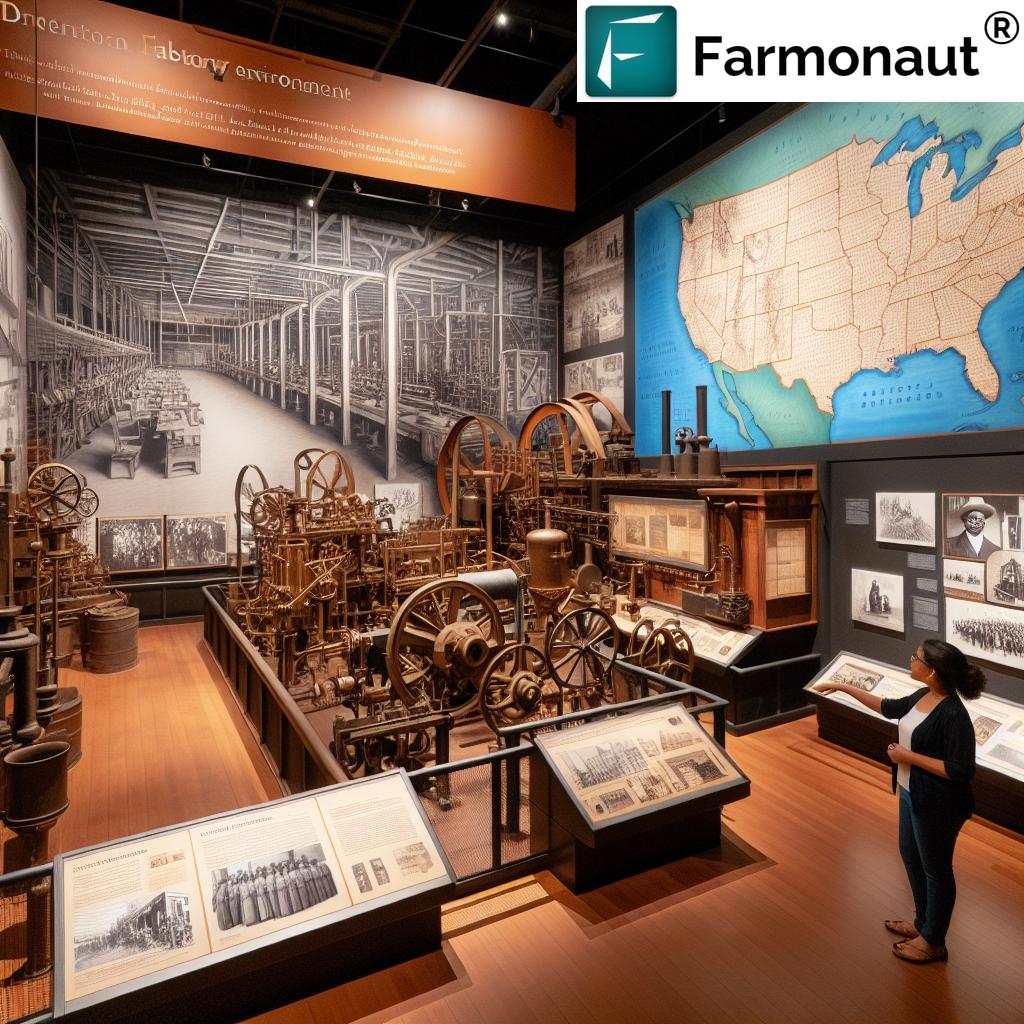Exploring African American Labor History: A Guide to Civil Rights Sites and Cultural Landmarks in the United States

“The Underground Railroad network included over 3,000 safe houses and secret routes across the United States.”
As we embark on this enlightening journey through African American labor history and civil rights sites across the United States, we invite you to explore the rich tapestry of experiences that have shaped our nation. In recognition of Black History Month 2025’s theme, “African Americans and Labor,” we’ll delve into the struggles, triumphs, and enduring legacy of Black Americans in the workplace and beyond.
From the era of slavery to modern contributions in education, healthcare, and community service, we’ll guide you through a comprehensive tour of African American cultural tourism destinations. Our exploration will take us to iconic landmarks, museums, and historical sites that tell the powerful story of resilience, determination, and progress.
The Journey Begins: Understanding African American Labor History
To truly appreciate the significance of African American labor history, we must first acknowledge the profound impact of slavery on the United States. The forced labor of enslaved Africans laid the foundation for much of the country’s early economic growth, particularly in the agricultural South. As we visit historical sites and museums, we’ll gain insights into this dark chapter of American history and the subsequent fight for freedom and equality.
- The Underground Railroad: A network of secret routes and safe houses used by enslaved people to escape to free states and Canada
- Emancipation and Reconstruction: The period following the Civil War, marked by new opportunities and challenges for freed African Americans
- The Great Migration: The movement of millions of African Americans from the rural South to urban areas in the North, Midwest, and West
- Civil Rights Movement: The struggle for equal rights and opportunities in all aspects of American life, including the workplace
As we explore these pivotal moments in history, we’ll also highlight the contributions of African Americans to various industries, from agriculture and manufacturing to education and the arts. By understanding this rich history, we can better appreciate the significance of the landmarks and cultural sites we’ll visit on our journey.
Essential Resources for Your African American Cultural Tourism Experience
Before we embark on our tour of civil rights sites and cultural landmarks, let’s equip ourselves with some valuable resources to enhance our experience:
- National Museum of African American History & Culture: The “Invisible Changemakers of Industry” digital toolkit offers insights into African American contributions across various fields.
- Black-owned businesses and restaurants: Support local entrepreneurs and experience authentic cuisine by visiting establishments featured in tourism resources.
- National Park Service’s Journey to Freedom: This resource connects over 750 sites related to the Underground Railroad, providing a comprehensive look at this crucial network.
- Civil Rights Trail websites: Many states and cities offer dedicated websites highlighting local civil rights landmarks and their significance.
By utilizing these resources, we can deepen our understanding and make the most of our visits to historical sites and cultural landmarks.
Landmark Destinations: Tracing African American Labor History
Our journey through African American labor history takes us to several significant locations across the United States. Each of these sites offers a unique perspective on the struggles and triumphs of Black Americans in the workplace and beyond.
1. Mount Vernon and Monticello: Understanding Slavery’s Impact
We begin our tour at two iconic presidential estates: Mount Vernon, the home of George Washington, and Monticello, Thomas Jefferson’s residence. These sites provide crucial insights into the lives of enslaved individuals who worked on these plantations. By participating in tours focused on the experiences of enslaved people, we can reflect on the harsh realities of slavery and its lasting impact on American labor history.
- Mount Vernon’s Enslaved People of Mount Vernon Tour
- Monticello’s Slavery at Monticello Tour
These tours offer a sobering look at the foundation of early American labor and the individuals whose forced work built the nation’s economy.
2. Boston’s Black History Trail: Exploring 19th-Century African American Communities
Our next stop takes us to Boston, where we’ll explore the vibrant 19th-century African American community through the Black History Trail. This self-guided tour leads visitors through significant sites that highlight the contributions of African Americans to the city’s history and culture.
- African Meeting House: The oldest surviving Black church building in the United States
- Abiel Smith School: The first public school for African American children in Boston
- Robert Gould Shaw and the 54th Regiment Memorial: Honoring one of the first African American regiments to fight in the Civil War
As we walk this trail, we’ll gain a deeper appreciation for the roles African Americans played in shaping Boston’s history, from the American Revolution to the abolitionist movement and beyond.
3. North Carolina’s Civil Rights Trail: A Journey Through Struggle and Triumph
Continuing our exploration, we venture to North Carolina, where the Civil Rights Trail offers a powerful look at the state’s role in the fight for equality. This trail connects various historic sites that played crucial roles in the civil rights movement and African American labor history.
- Pauli Murray Center for History and Social Justice, Durham
- International Civil Rights Center & Museum, Greensboro
- Harvey B. Gantt Center for African American Arts + Culture, Charlotte
The International Civil Rights Center & Museum, located at the site of the Greensboro sit-ins, provides a particularly poignant reminder of the bravery and determination of civil rights activists. These peaceful protests at segregated lunch counters sparked a nationwide movement and played a crucial role in advancing workplace equality.

4. Jackson, Mississippi: Heart of the Civil Rights Movement
Our journey takes us to Jackson, Mississippi, a city at the epicenter of the civil rights movement. Here, we’ll explore several significant sites that highlight the struggles and triumphs of African Americans in their quest for equality and fair labor practices.
- Mississippi Civil Rights Museum: A comprehensive look at the state’s civil rights history
- Medgar Evers Home Museum: Honoring the life and legacy of the civil rights leader
- Freedom Corner: A memorial to those who fought for civil rights in Mississippi
The Mississippi Civil Rights Museum, in particular, offers a powerful and immersive experience, showcasing the stories of individuals like Hezekiah Watkins, a young Freedom Rider who risked his life for equality. These exhibits remind us of the courage and sacrifice of those who fought for freedom and fair treatment in all aspects of life, including the workplace.
“African Americans make up approximately 13% of the US population but represent 24% of workers in education and health services.”
5. Chicago: A Hub of African American Culture and Industry
Our exploration of African American labor history wouldn’t be complete without a visit to Chicago, a city that played a pivotal role in the Great Migration and the development of Black culture and industry in the North.
- DuSable Black History Museum and Education Center: The oldest independent Black history museum in the United States
- Bronzeville Children’s Museum: Focusing on African American contributions to society
- A. Philip Randolph Pullman Porter Museum: Highlighting the first Black labor union chartered in America
The A. Philip Randolph Pullman Porter Museum is particularly relevant to our exploration of African American labor history. It tells the story of the Brotherhood of Sleeping Car Porters, which played a crucial role in advancing labor rights for African Americans in the early 20th century.
African American Contributions to Industry and Labor
As we journey through these historical sites, it’s important to recognize the vast contributions African Americans have made to various industries throughout U.S. history. From agriculture and manufacturing to education and healthcare, Black Americans have played crucial roles in shaping the nation’s economy and workforce.
Agriculture and Farming
African Americans have a long and complex history with agriculture in the United States. From the forced labor of slavery to the struggles of sharecropping and the innovations of Black farmers, this industry has been deeply intertwined with African American experiences.
- George Washington Carver’s agricultural research and innovations
- The rise of Black-owned farms and agricultural cooperatives
- Modern initiatives supporting Black farmers and sustainable agriculture
Today, organizations like the National Black Farmers Association work to support and advocate for African American farmers across the country.
Manufacturing and Industry
During the Great Migration, many African Americans found work in Northern factories and industrial centers. These jobs, while often difficult and dangerous, provided opportunities for economic advancement and played a crucial role in the growth of the Black middle class.
- The Ford Motor Company’s integration of its workforce in the 1910s and 1920s
- African American contributions to the steel industry in Pittsburgh and other industrial centers
- The role of Black workers in wartime production during World War II
Museums like the Charles H. Wright Museum of African American History in Detroit offer exhibits that highlight these industrial contributions.
Education and Healthcare
African Americans have made significant contributions to the fields of education and healthcare, often in the face of severe discrimination and limited resources.
- The establishment of Historically Black Colleges and Universities (HBCUs)
- Pioneering medical researchers like Dr. Charles Drew and Dr. Daniel Hale Williams
- The crucial role of Black nurses during wartime and public health crises
Sites like the Mary McLeod Bethune Council House National Historic Site in Washington, DC, celebrate the legacy of African American educators and their impact on American society.
| Year | Event/Landmark | Location | Significance |
|---|---|---|---|
| 1619 | Arrival of first enslaved Africans | Jamestown, Virginia | Beginning of slavery in British North America |
| 1793 | Invention of the cotton gin | Georgia | Increased demand for slave labor in the South |
| 1831-1861 | Underground Railroad | Various locations across the US | Network of secret routes and safe houses for escaping slaves |
| 1863 | Emancipation Proclamation | Washington, DC | Declared slaves in Confederate states free |
| 1865 | 13th Amendment | United States | Officially abolished slavery throughout the US |
| 1881 | Tuskegee Institute founded | Tuskegee, Alabama | Booker T. Washington’s school for African American education |
| 1910-1970 | Great Migration | Various US cities | Mass movement of African Americans from the rural South to urban North |
| 1925 | Brotherhood of Sleeping Car Porters founded | New York City | First African American labor union to receive a charter in the AFL |
| 1955-1968 | Civil Rights Movement | Various locations across the US | Mass movement for racial equality and civil rights |
| 1963 | March on Washington for Jobs and Freedom | Washington, DC | Landmark civil rights demonstration; Martin Luther King Jr.’s “I Have a Dream” speech |
| 1964 | Civil Rights Act | United States | Outlawed discrimination based on race, color, religion, sex, or national origin |
| 1965 | Voting Rights Act | United States | Prohibited racial discrimination in voting |
| 2016 | National Museum of African American History and Culture opens | Washington, DC | Smithsonian museum dedicated to African American history and culture |
Supporting Black-Owned Businesses: A Continuation of Labor History
As we reflect on African American labor history, it’s crucial to recognize and support Black-owned businesses today. These enterprises represent a continuation of the struggle for economic empowerment and equality that has been a central theme throughout African American history.
- Use local tourism resources to find and patronize Black-owned restaurants, shops, and service providers
- Explore online directories of Black-owned businesses across various industries
- Consider staying at Black-owned hotels or bed and breakfasts during your travels
By supporting these businesses, we not only contribute to the local economy but also honor the legacy of African American entrepreneurship and innovation.
Educational Resources for Deeper Understanding
To further enrich our exploration of African American labor history, we recommend utilizing these educational resources:
- The National Archives’ “Black Power” digital exhibit
- The Library of Congress’ “African American Odyssey” collection
- The Schomburg Center for Research in Black Culture’s digital collections
- The African American National Biography, a joint project of Harvard University and Oxford University Press
These resources provide in-depth information on various aspects of African American history, including labor movements, civil rights struggles, and cultural contributions.
Planning Your Journey: Tips for Visiting Civil Rights Sites
As you plan your exploration of African American labor history and civil rights sites, consider these tips to make the most of your experience:
- Research in advance: Many sites offer guided tours or special programs that can enhance your visit
- Allow ample time: These locations often contain powerful, emotional exhibits that deserve thoughtful reflection
- Engage with local communities: Attend local events or talks related to African American history and culture
- Document your journey: Consider keeping a travel journal or blog to reflect on your experiences
- Respect the sites: Remember that many of these locations are places of profound historical significance and should be treated with reverence
By approaching these visits with an open mind and a willingness to learn, we can gain a deeper understanding of African American labor history and its ongoing impact on our society.
The Future of African American Labor and Industry
As we conclude our journey through African American labor history, it’s important to look towards the future. African Americans continue to make significant contributions across various industries, from technology and finance to arts and entertainment.
- The growing presence of African Americans in STEM fields
- Increasing representation in corporate leadership positions
- The impact of Black entrepreneurs in the startup ecosystem
- Ongoing efforts to address racial disparities in the workplace
By understanding the historical context of African American labor and celebrating current achievements, we can work towards a more equitable and inclusive future for all workers.
Conclusion: Honoring the Legacy of African American Labor
Our journey through African American labor history and civil rights sites has taken us across the United States, from the painful legacy of slavery to the triumphs of the civil rights movement and beyond. By visiting these landmarks and engaging with the stories they tell, we gain a deeper appreciation for the struggles and achievements of African Americans in the workplace and society at large.
As we reflect on this history, let us commit to continuing the work of creating a more just and equitable society. By supporting Black-owned businesses, educating ourselves and others, and actively working to address racial disparities, we can honor the legacy of those who came before us and pave the way for a brighter future.
We encourage you to embark on your own journey of discovery, visiting these sites and engaging with the rich tapestry of African American labor history. By doing so, we not only learn about our past but also gain valuable insights that can guide us towards a more inclusive and equitable future for all Americans.
FAQ: Exploring African American Labor History and Civil Rights Sites
Q: What is the significance of the Black History Month 2025 theme “African Americans and Labor”?
A: This theme highlights the crucial contributions of African Americans to the U.S. workforce throughout history, from slavery to modern industries. It encourages exploration of labor movements, workplace struggles, and achievements across various sectors.
Q: How can I plan a trip to visit multiple African American historical sites?
A: Start by researching key locations like the National Museum of African American History & Culture in Washington, DC, and state-specific civil rights trails. Use resources from the National Park Service and local tourism boards to create an itinerary that covers significant landmarks in your chosen region.
Q: Are there any apps or digital tools to enhance my visit to these historical sites?
A: Yes, many museums and historical sites offer mobile apps with audio tours and additional information. The National Park Service also has apps for various historical trails. Additionally, websites like the Civil Rights Trail (civilrightstrail.com) provide interactive maps and detailed site information.
Q: How can I support Black-owned businesses during my travels?
A: Use online directories like the Official Black Wall Street app or EatOkra to find Black-owned restaurants and shops in the areas you’re visiting. Many cities also have local guides or tourism websites that highlight Black-owned businesses.
Q: What are some key books to read to learn more about African American labor history?
A: Some recommended reads include “The Warmth of Other Suns” by Isabel Wilkerson, “A. Philip Randolph: A Life in the Vanguard” by Andrew E. Kersten, and “At the Dark End of the Street” by Danielle L. McGuire.
Earn With Farmonaut: Affiliate Program
Earn 20% recurring commission with Farmonaut’s affiliate program by sharing your promo code and helping farmers save 10%. Onboard 10 Elite farmers monthly to earn a minimum of $148,000 annually—start now and grow your income!
For developers interested in integrating Farmonaut’s technology, check out our API and API Developer Docs.






